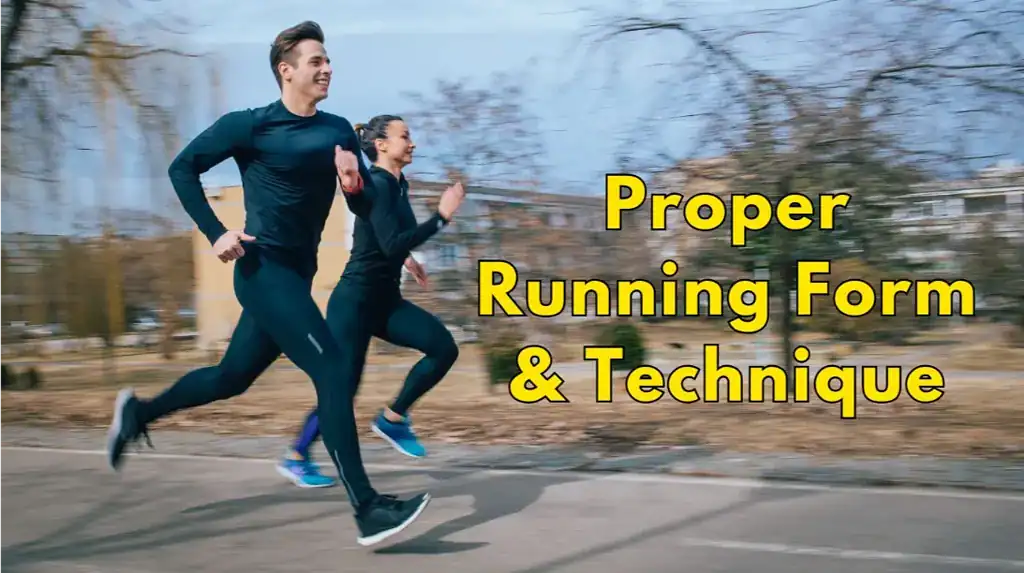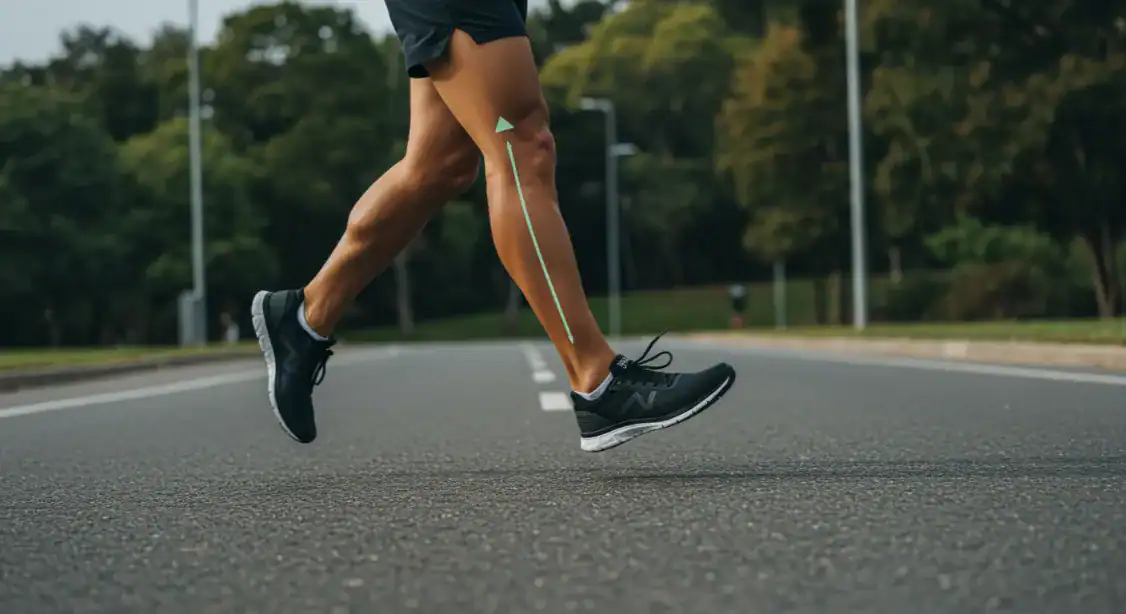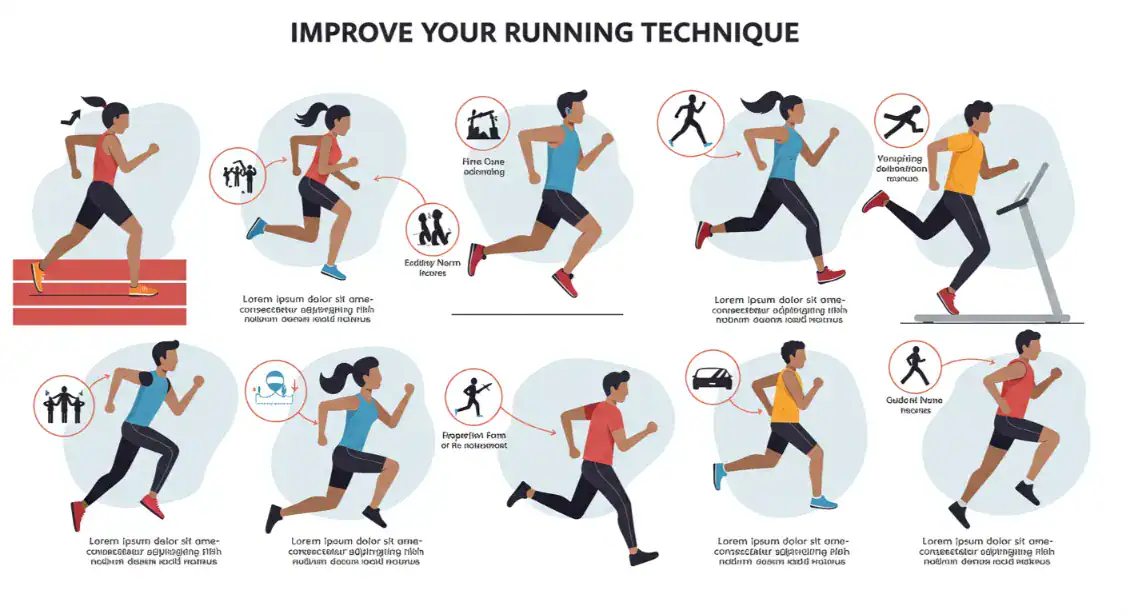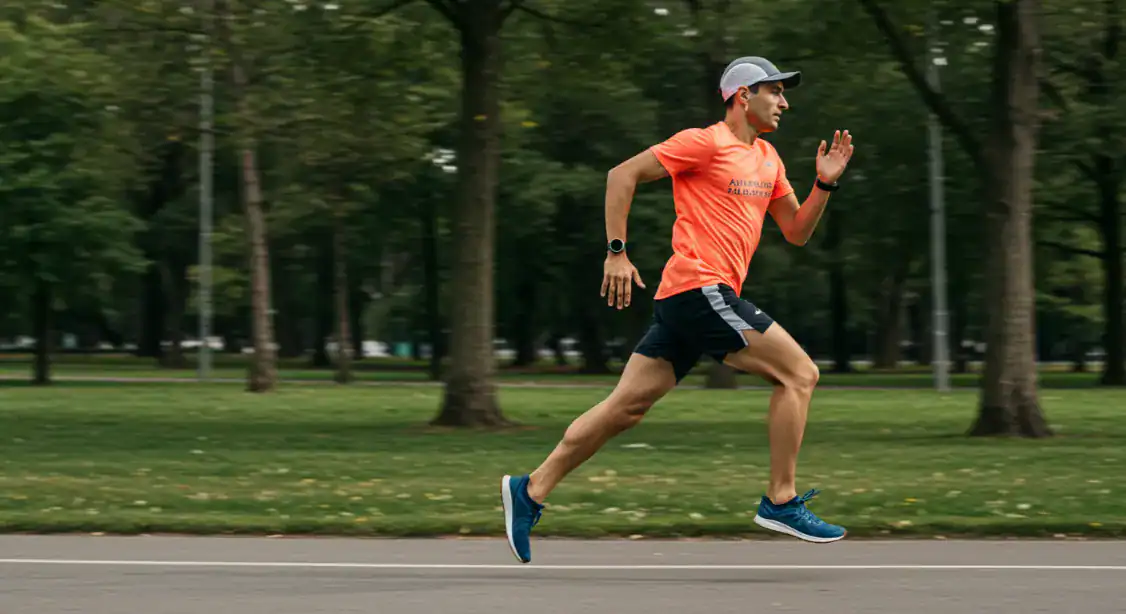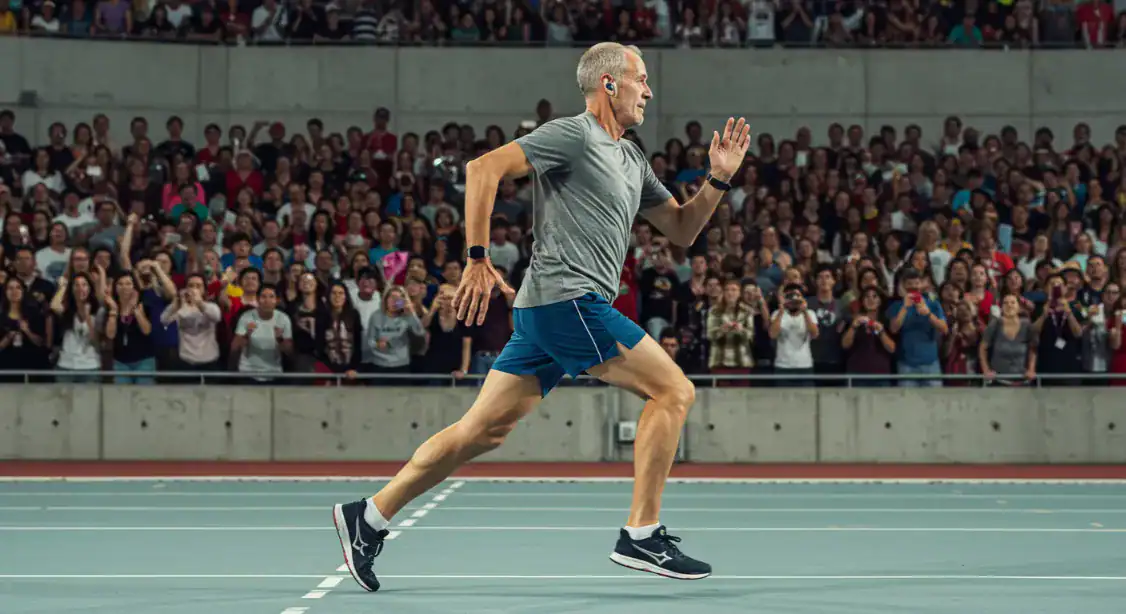Running seems simple enough—put one foot in front of the other and repeat. But anyone who’s tried to improve their performance or struggled with running-related injuries knows there’s much more to it.
Good running technique isn’t just about looking smooth; it’s about moving efficiently, staying injury-free, and enjoying the run.
Key Takeaways
- Proper posture—head up, shoulders relaxed, slight forward lean—creates the foundation for efficient running
- Midfoot striking generally creates less impact than heel striking for most runners
- Aim for a cadence around 170-180 steps per minute to reduce impact forces
- Core engagement is essential for stability and power transfer during running
- Regular form drills improve muscle memory and running mechanics
- Breathing techniques can significantly enhance running efficiency and endurance
The Foundations of Good Running Form
Running isn’t just about strong legs—it’s a full-body movement requiring coordination from head to toe. Let’s break down what makes good form.
Posture: Stand Tall, Run Light
Your mother was right about standing up straight. When running, imagine a string pulling you upward from the crown of your head. Keep your gaze forward about 10-20 feet ahead—not at your feet. This helps align your neck with your spine and prevents the common hunched position that restricts breathing and creates tension.
Your shoulders should stay relaxed—not hiked up around your ears. Many runners hold tension here without realizing it, especially when fatigue sets in. Periodically shaking out your arms during a run can help release this tension.
A slight forward lean should come from the ankles, not by bending at the waist. This slight lean uses gravity to your advantage and reduces the effort needed to move forward. Think about falling forward slightly while maintaining a straight line from head to ankle.
Foot Strike: Finding What Works
Few topics in running generate more debate than foot strike—whether to land on your heel, midfoot, or forefoot. The truth is more nuanced than many realize.
Most research suggests that midfoot striking creates less impact force than landing heavily on the heel. However, forcing an unnatural foot strike pattern can create new problems. Instead, focus on landing with your foot relatively flat and close to underneath your center of mass, rather than reaching far forward with each step.
If you’re currently a heel striker experiencing no injuries, making a dramatic change might not be necessary. But if you’re dealing with recurring injuries, gradually shifting toward a midfoot strike could help reduce impact forces traveling up your legs.
Stride Length and Cadence
Many recreational runners overstride—reaching too far forward with each step. This creates a braking effect with each landing and increases impact forces. Instead of focusing on lengthening your stride, work on increasing your cadence (steps per minute).
The ideal cadence varies by individual, but most efficient runners maintain approximately 170-180 steps per minute. A higher cadence generally reduces overstriding and decreases the time your foot spends in contact with the ground.
To check your current cadence, count your steps for 30 seconds during a comfortable run, then multiply by two. If you’re well below 170, gradually work on increasing your turnover. Using a metronome app or music with the right beats per minute can help you find and maintain this rhythm.
The Forgotten Elements: Upper Body and Core
While legs get most of the attention in running, your upper body plays a crucial role in efficiency and form.
Arm Swing: Your Natural Counterbalance
Your arms provide critical balance and rhythm to your running. Keep elbows bent at roughly 90 degrees, with hands relaxed—imagine holding a potato chip without crushing it. Your arms should swing naturally forward and back, not across your body, which can create rotational forces that waste energy.
The power and speed of your arm swing directly relates to leg turnover. When you need to surge up a hill or sprint to the finish, pumping your arms faster will naturally increase your stride frequency.
Core Engagement: Your Power Center
A strong, engaged core is the foundation of good running form. Your core includes not just your abs but the entire set of muscles surrounding your trunk and pelvis. These muscles stabilize your pelvis during running, preventing excessive rotation and maintaining proper alignment.
When your core is weak or disengaged, your pelvis may drop to one side as you land (a common issue called hip drop), which can lead to IT band problems, knee pain, and other injuries. Regular core strengthening exercises specifically targeting the stabilizing muscles should be part of every runner’s routine.
Common Form Mistakes and Fixes
Even experienced runners can develop form issues, especially as fatigue sets in. Here are some frequent problems and their solutions:
1. Bouncing Too Much Vertically
Excessive up-and-down movement wastes energy that should be directed forward. Focus on a lower, smoother stride, keeping your center of gravity relatively stable throughout your run.
2. Crossing Arms Over the Midline
When arms swing across your body, you create rotational forces that can waste energy and potentially lead to injuries. Practice keeping your arm swing parallel to your running direction, with hands passing close to your hips.
3. Looking Down at Your Feet
This throws off your entire posture chain. Practice keeping your gaze forward, which naturally aligns your neck and spine properly.
4. Clenched Hands and Tense Shoulders
Tension anywhere wastes valuable energy. Periodically check in with your body during runs, intentionally relaxing your hands, dropping your shoulders, and releasing your jaw.
5. Landing Too Far in Front of Your Body
This creates a braking effect with each step. Focus on landing with your foot closer to beneath your center of mass, using your glutes to power your stride rather than reaching with your legs.
Practical Drills to Improve Your Form
Reading about good form is helpful, but your body needs to practice these movements to make them automatic. Incorporate these drills into your warm-up routine:
High Knees
Run in place while lifting knees to hip height, focusing on quick foot contacts and good posture. This drill enhances hip flexibility and promotes midfoot striking.
Butt Kicks
Jog slowly while kicking your heels toward your glutes, keeping your thighs relatively perpendicular to the ground. This drill improves hamstring recovery and foot lift after push-off.
Skipping Drills
A-skips and B-skips help develop proper knee drive and foot placement while reinforcing the basic mechanics of good running form.
Strides
After warming up, do 4-8 accelerations of about 20-30 seconds, gradually building to about 85-90% of your maximum speed while focusing intently on form. These aren’t all-out sprints but controlled fast running with excellent technique.
The Role of Breathing in Running
Your breathing technique while running significantly affects your performance and comfort. Many runners breathe too shallowly, not fully utilizing their lung capacity.
Practice diaphragmatic breathing—breathing deeply into your belly rather than just your upper chest. Your abdomen should expand as you inhale, allowing your lungs to fill more completely.
Experiment with different breathing patterns. Many runners find that a 3:2 pattern (inhaling for three steps, exhaling for two) works well at moderate speeds, while a 2:2 or 2:1 pattern might be needed for higher intensities.
Tools for Analyzing Your Form
Getting feedback on your running form can accelerate improvement:
Video Analysis
Have someone film you running from the front, side, and behind. Watch the footage in slow motion to identify issues with your form. Many running specialty stores offer this service, or you can do a basic version yourself with a smartphone.
Mirror Check
Running on a treadmill facing a mirror provides immediate visual feedback, helping you make real-time adjustments to your form.
Professional Assessment
Consider visiting a running coach or physical therapist specializing in runners. They can provide personalized feedback and specific drills to address your particular form issues.
When to Focus on Form (And When Not To)
There are appropriate times to think about your technique, and times when it’s counterproductive:
Good Times for Form Focus:
- During warm-ups and cool-downs
- On easy runs when you’re not fatigued
- During specific technique-focused workouts
- At the beginning of speed sessions
When to Let Form Flow Naturally:
- During races (except brief mental check-ins)
- When pushing hard on challenging workouts
- When running should be joyful and meditative
Remember that running form is highly individual. While certain principles apply universally, the perfect form for you depends on your unique body structure, strengths, weaknesses, and running goals.
The Connection Between Strength and Form
Good running form requires sufficient strength in key muscle groups. If your muscles fatigue quickly, your form will deteriorate no matter how well you understand proper technique.
Incorporate regular strength training into your routine, focusing especially on:
- Glutes and hip stabilizers
- Core (including deep abdominal muscles)
- Calves and ankles
- Upper back and posture muscles
These strength exercises don’t need to be complex or time-consuming. Even 15-20 minutes of targeted exercises 2-3 times per week can dramatically improve your ability to maintain good form throughout your runs.
Adapting Your Form for Different Situations
Good running form isn’t static—it should adapt to different circumstances:
Uphill Running
Lean slightly more into the hill, shorten your stride, and focus on driving your knees forward and up. Your arm swing becomes more important for maintaining momentum.
Downhill Running
Avoid the common mistake of leaning back and braking with each step. Instead, increase your cadence and take shorter steps while maintaining a slight forward lean. Let gravity do some of the work while staying in control.
Trail Running
Trail running requires more agility and awareness. Keep your gaze a bit closer to your feet to spot obstacles, lift your feet slightly higher, and be prepared to adjust your stride length constantly based on terrain.
Racing
During races, your form may naturally become more aggressive—with a more powerful arm swing and stronger push-off. This is appropriate for short-term performance but would be inefficient for everyday training.
The Mental Side of Good Form
Running technique isn’t just physical—it’s mental too. Developing body awareness and mindfulness during running can help you make subtle adjustments before small form issues become problematic.
Practice occasional “form check-ins” during your runs, briefly assessing your posture, relaxation level, foot strike, and other key elements. This awareness builds the neural connections needed for your body to automatically maintain good form even when you’re not consciously thinking about it.
Patience with the Process
Changing running form takes time—typically months of consistent practice. Your muscles, tendons, and nervous system all need time to adapt to new movement patterns. Rushing this process often leads to injury.
If you’re making significant form changes, reduce your running volume temporarily and be especially attentive to any new aches or pains that develop. Gradually build back up as your body adapts to the new mechanics.
Conclusion
Improving your running technique is a journey, not a destination. Even elite runners continually refine their form throughout their careers. Be patient with yourself, incorporate regular form drills and strength work, and pay attention to how different techniques affect how you feel during and after runs.
The best running form is one that allows you to run efficiently, comfortably, and injury-free for the long haul. Focus less on looking perfect and more on finding the movement patterns that work best for your unique body and goals.
Remember that running should ultimately be enjoyable. While good form is important, don’t become so obsessed with technique that you lose the joy of simply moving through space under your own power—that freedom is why many of us fell in love with running in the first place.
References
- American Council on Exercise – Running Technique
- Journal of Sports Sciences – Running Mechanics
- British Journal of Sports Medicine – Injury Prevention
- Medicine & Science in Sports & Exercise
- The Runner’s Body: How the Latest Exercise Science Can Help You Run Stronger, Longer, and Faster
As a veteran fitness technology innovator and the founder of GearUpToFit.com, Alex Papaioannou stands at the intersection of health science and artificial intelligence. With over a decade of specialized experience in digital wellness solutions, he’s transforming how people approach their fitness journey through data-driven methodologies.
